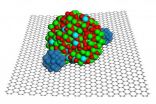(Press-News.org) Researchers from Northwestern University and the Massachusetts Institute of Technology (MIT) have studied individual water droplets and discovered a miniature version of the "water hammer," an effect that produces the familiar radiator pipe clanging in older buildings.
In piping systems, the water hammer occurs when fluid is forced to stop abruptly, causing huge pressure spikes that can rupture pipe walls. Now, for the first time, the researchers have observed this force on the scale of microns: such pressure spikes can move through a water droplet, causing it to be impaled on textured superhydrophobic surfaces, even when deposited gently.
This insight of how droplets get stuck on surfaces could lead to the design of more effective superhydrophobic, or highly water-repellant, surfaces for condensers in desalination and steam power plants, de-icing for aircraft engines and wind turbine blades, low-drag surfaces in pipes and even raincoats. In certain cases, improved surfaces could improve energy efficiency on many orders of magnitude. (About half of all electricity generated in the world comes from steam turbines.)
The research is published by the journal Physical Review Letters.
"We want to design surface textures that will cause the water to really hate those surfaces," said Neelesh A. Patankar, associate professor of mechanical engineering at Northwestern's McCormick School of Engineering and Applied Science. "Improving current hydrophobic materials could result in a 60 percent drag reduction in some applications, for example."
Patankar collaborated with Kripa K. Varanasi, the d'Arbeloff Assistant Professor of Mechanical Engineering at MIT. The two are co-corresponding authors of the paper. Patankar initiated this study in which he and Varanasi led the analytical work, and the experiments were conducted at MIT in Varanasi's lab. Other co-authors are MIT mechanical engineering graduate students Hyuk-Min Kwon and Adam Paxson.
In designing superhydrophobic surfaces, one goal is to produce surfaces much like the natural lotus leaf. Water droplets on these leaves bead up and roll off easily, taking any dirt with them. Contrary to what one might think, the surface of the leaves is rough, not smooth. The droplets sit on microscopic bumps, as if resting on a bed of nails.
"If a water droplet impales the grooves of this bumpy texture, it becomes stuck instead of rolling off," Patankar said. "Such transitions are well known for small static droplets. Our study shows that the impalement of water is very sensitive to the dynamic 'water hammer' effect, which was not expected."
To show this, the researchers imaged millimeter-scale water droplets gently deposited onto rough superhydrophobic surfaces. (The surfaces were made of silicon posts, with spacing from post edge to post edge ranging from 40 to 100 microns, depending on the experiment.) Since these drops were on the millimeter scale and being deposited gently, prior understanding was to assume that gravitational force is not strong enough to push the water into the roughness grooves. The Northwestern and MIT researchers are the first to show this is not true.
They observed that as a droplet settles down on the surface (due to the drop's own weight) there is a rapid deceleration in the drop that produces a brief burst of high pressure, sending a wave through the droplet. The droplet is consequently pinned on the rough surface. That's the powerful mini water hammer effect at work.
By understanding the underlying physics of this transition, the study reveals that there is actually a window of droplet sizes that avoid impalement. Although focused on drop deposition, this idea is quite general and applies to any scenario where the water velocity is changing on a short (less than a millisecond) time scale. This insight can lead to the design of more robust superhydrophobic surfaces that can resist water impalement even under the dynamic conditions typical in industrial setups.
"One way to reduce impalement is to design a surface texture that results in a surface that sustains extremely high pressures," Patankar said. "It is the length scale of the roughness that is important." To resist impalement, the height of a bump and the distance between bumps need to be just right. Hundreds of nanometer scale roughness can lead to robust surfaces.
"Our ultimate goal," he added, "is the invention of textured surfaces such that a liquid in contact with it will, at least partially, vaporize next to the surface -- or sustain air pockets -- and self-lubricate. This is similar to how an ice skater glides on ice due to a cushion of thin lubricating liquid film between the skates and the ice. A critical step is to learn how to resist impalement of water on the roughness. Our work on water hammer-induced impalement is a crucial advance toward that goal of ultra-slippery vapor stabilizing surfaces."
The paper is titled "Rapid Deceleration-driven Wetting Transition During Pendant Drop Deposition on Superhydrophobic Surfaces."
### END
Not just for raincoats
Discovery of mini 'water hammer' effect could lead to materials that water really hates
2011-02-09
ELSE PRESS RELEASES FROM THIS DATE:
Growing population of adult survivors of congenital heart disease requires specialized care
2011-02-09
Philadelphia, PA, February 8, 2011 – For the one in 200 adults in Western societies born with congenital heart disease, adult survivors face a lifelong process of medical interactions. Treatments received during neonatal, childhood, and adolescent years affect future adult events. In the January/February issue of Progress in Cardiovascular Diseases ten articles explore our current understanding of adult congenital heart disease (ACHD) in survivors.
This issue of Progress in Cardiovascular Diseases is dedicated to exploring the path to and current understanding of lifelong ...
Medication education key to successful adherence in patients with diabetes
2011-02-09
Researchers at the Skaggs School of Pharmacy and Pharmaceutical Sciences at the University of California, San Diego say that medication education is a key factor in helping patients with diabetes better stick to their drug treatments plans. The study, currently on line in the February issue of the journal Annals of Pharmacotherapy, points to the need for pharmacists and other health care providers to assess reasons why some patients don't adhere to their medication plans, and to provide counseling opportunities to help them.
"Counseling can be more effective if pharmacists ...
A paperweight for platinum
2011-02-09
RICHLAND, Wash. -- A new combination of nanoparticles and graphene results in a more durable catalytic material for fuel cells, according to work published today online at the Journal of the American Chemical Society. The catalytic material is not only hardier but more chemically active as well. The researchers are confident the results will help improve fuel cell design.
"Fuel cells are an important area of energy technology, but cost and durability are big challenges," said chemist Jun Liu. "The unique structure of this material provides much needed stability, good ...
Understanding patterns of seafloor biomass
2011-02-09
Analysis of a comprehensive database has revealed strong links between biological productivity in the surface oceans and patterns of biomass and abundance at the seafloor, helping to explain large regional differences. The research was conducted by an international, multi-institutional research team including scientists from the National Oceanography Centre (NOC), and incorporated data from the Census of Marine Life (CoML).
The vast majority of the biological production in the world's oceans occurs within sunlit surface waters – the so-called photic zone. Through the ...
Cross-border conservation vital to protect birds in a climate-change world
2011-02-09
Countries need to increase co-operation over conservation to protect birds and other wildlife in an era of climate change, according to a new continental-scale study.
Experts have established a new conservation index to help policy-makers to deal with the effects of climate change on birds in Africa, and it could assist governments across the world to protect wildlife areas and help species as climate change forces them to move to new areas.
It is the first categorisation of protected areas to show how conservationists might deal with climate change and the shuffling ...
Virtual laboratory predicts train vibrations
2011-02-09
The construction of new rail lines, or the relocation of old ones underground, has increased society's interest over recent years in the vibrations produced by trains, especially among people who live or work near the tracks. Now a study headed by the Polytechnic University of Valencia (UPV) has made it possible to estimate the trajectory of vibrations from the point at which they are generated (wheel-rail contact) through to the ground.
"The model acts as a "virtual train laboratory', meaning that, if the parameters of the train or the track ballast are changed, it is ...
Experts call for greater awareness of the links between diabetes and kidney disease
2011-02-09
The first time that many patients realise that diabetes can affect their kidneys is when they are referred to renal services, according to a multi-cultural study in the March issue of the Journal of Renal Care.
UK researchers who spoke to 48 patients with diabetes attending specialist renal services in Leicester, Luton and Ealing, discovered that awareness of the kidney risks posed by the disease was very low.
"The people we spoke to experienced feelings of surprise, fear and regret when they found out their kidney had been affected" says Professor Gurch Randhawa, ...
Extra testosterone reduces your empathy
2011-02-09
A new study from Utrecht and Cambridge Universities has for the first time found that an administration of testosterone under the tongue in volunteers negatively affects a person's ability to 'mind read', an indication of empathy. The findings are published this week in the journal Proceedings of the National Academy of Sciences.
In addition, the effects of testosterone administration are predicted by a fetal marker of prenatal testosterone, the 2D:4D ratio. The study has important implications for the androgen theory of autism (testosterone is an androgen) and confirms ...
Drug-eluting stents are preferred therapy for revascularization of chronic total occlusions
2011-02-09
A systematic review of medical evidence has determined drug-eluting stents (DES) outperform bare metal stents (BMS) for revascularization of chronic total occlusions. Researchers found coated stents reduce restenosis and target revascularization, offering a safe approach with similar adverse events as BMS. Full findings are available in the February issue of Catheterization and Cardiovascular Interventions, a journal published by Wiley-Blackwell on behalf of The Society for Cardiovascular Angiography and Interventions.
Medical evidence maintains that chronic total occlusions ...
Ancient teeth raise new questions about the origins of modern man
2011-02-09
BINGHAMTON, NY – Eight small teeth found in a cave near Rosh Haain, central Israel, are raising big questions about the earliest existence of humans and where we may have originated, says Binghamton University anthropologist Rolf Quam. Part of a team of international researchers led by Dr. Israel Hershovitz of Tel Aviv University, Qaum and his colleagues have been examining the dental discovery and recently published their joint findings in the American Journal of Physical Anthropology.
Excavated at Qesem cave, a pre-historic site that was uncovered in 2000, the size ...
LAST 30 PRESS RELEASES:
National poll: Less than half of parents say swearing is never OK for kids
Decades of suffering: Long-term mental health outcomes of Kurdish chemical gas attacks
Interactional dynamics of self-assessment and advice in peer reflection on microteaching
When aging affects the young: Revealing the weight of caregiving on teenagers
Can Canada’s health systems handle increased demand during FIFA World Cup?
Autistic and non-autistic faces may “speak a different language” when expressing emotion
No clear evidence that cannabis-based medicines relieve chronic nerve pain
Pioneering second-order nonlinear vibrational nanoscopy for interfacial molecular systems beyond the diffraction limit
Bottleneck in hydrogen distribution jeopardises billions in clean energy
Lung cancer death rates among women in Europe are finally levelling off
Scientists trace microplastics in fertilizer from fields to the beach
The Lancet Obstetrics, Gynecology, & Women’s Health: Taking paracetamol during pregnancy does not increase risk of autism, ADHD or intellectual disabilities, confirms new gold-standard evidence review
Taking paracetamol during pregnancy does not increase risk of autism, ADHD or intellectual disabilities
Harm reduction vending machines in New York State expand access to overdose treatment and drug test strips, UB studies confirm
University of Phoenix releases white paper on Credit for Prior Learning as a catalyst for internal mobility and retention
Canada losing track of salmon health as climate and industrial threats mount
Molecular sieve-confined Pt-FeOx catalysts achieve highly efficient reversible hydrogen cycle of methylcyclohexane-toluene
Investment in farm productivity tools key to reducing greenhouse gas
New review highlights electrochemical pathways to recover uranium from wastewater and seawater
Hidden pollutants in shale gas development raise environmental concerns, new review finds
Discarded cigarette butts transformed into high performance energy storage materials
Researchers highlight role of alternative RNA splicing in schizophrenia
NTU Singapore scientists find new way to disarm antibiotic-resistant bacteria and restore healing in chronic wounds
Research suggests nationwide racial bias in media reporting on gun violence
Revealing the cell’s nanocourier at work
Health impacts of nursing home staffing
Public views about opioid overdose and people with opioid use disorder
Age-related changes in sperm DNA may play a role in autism risk
Ambitious model fails to explain near-death experiences, experts say
Multifaceted effects of inward foreign direct investment on new venture creation
[Press-News.org] Not just for raincoatsDiscovery of mini 'water hammer' effect could lead to materials that water really hates




